Minnesota State Capitol
|
Minnesota State Capitol | |
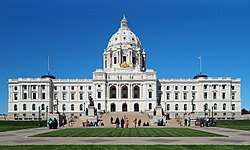 The Minnesota State Capitol from the south | |
  | |
| Location | 75 Rev. Martin Luther King Jr Boulevard, Saint Paul, Minnesota |
|---|---|
| Coordinates | 44°57′19″N 93°6′8″W / 44.95528°N 93.10222°WCoordinates: 44°57′19″N 93°6′8″W / 44.95528°N 93.10222°W |
| Built | 1905 |
| Architect | Cass Gilbert |
| Architectural style | Italian Renaissance, Beaux-Arts |
| NRHP reference # | 72000681 [1] |
| Added to NRHP | February 23, 1972 |
The Minnesota State Capitol is the seat of government for the U.S. state of Minnesota, in its capital city of Saint Paul. It houses the Minnesota Senate, Minnesota House of Representatives, the office of the Attorney General and the office of the Governor. The building also includes a chamber for the Minnesota Supreme Court, although court activities usually take place in the neighboring Minnesota Judicial Center.
The building is set in a landscaped campus. Various monuments are to its sides and front. Behind, a bridge spans University Avenue, and in front others were later added over the sunken roadway of Interstate 94, thus preserving the sight lines. Set near the crest of a hill, from the Capitol steps a panoramic view of downtown Saint Paul is presented.
Architecture
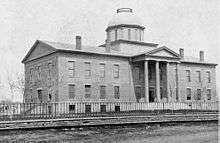
The building was built by Butler-Ryan Construction and designed by Cass Gilbert and modeled after Saint Peter's Basilica in Rome—the unsupported marble dome is the second largest in the world, after Saint Peter's. However, like all capitols with domes in the US it is also inspired by the idea of domed capitols originating with the United States Capitol dome. Work began on the capitol in 1896, its corner-stone laid July 27, 1898, and construction was completed in 1905. It is the third building to serve this purpose: the first capitol was destroyed by fire in 1881, and the second was completed in 1883, but was considered to be too small almost immediately.
Above the southern entrance to the building is a gilded quadriga called The Progress of the State which was sculpted by Daniel Chester French and Edward Clark Potter. It was completed and raised to the roof of the capitol in 1906. The four horses represent the power of nature: earth, wind, fire and water. The women leading the horses symbolize civilization, and the man on the chariot represents prosperity.[2] In 1994 and 1995, the statues underwent a restoration procedure which included replacing the gold leaf on the figures. A sphere perched above the capitol dome also has similar treatment.
Any classical dome built since Michelangelo's must expect to be compared to it, and Gilbert's dome is a frank homage, with interesting differences. His drawings show that he originally planned a wider drum and, correspondingly, a more massive dome. The smaller dome as built could be criticized by some as too small. It is smaller than St. Peter's and has a simplified design: single columns round the upper lantern instead of double ones, for instance. The ribs on the capitol dome are less pronounced than those on St. Peter's, but they are still visually apparent. Gilbert knew that St. Peter's dome was on the edge of being unstable: it had cracked and had to be reinforced. His engineer for this project, Gunvald Aus, bound the brick dome in reinforcing steel bands, and Gilbert crowned the paired columns round the drum (which act as buttresses to counter the dome's weight) with additional stone. Other than St. Peter's, additional buildings with marble domes include the Taj Mahal in India, and the Rhode Island State House in the city of Providence.
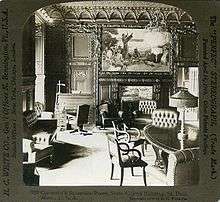
The central block under the dome needed three entrances, and Gilbert avoided creating visual references to a triumphal arch, which would have been inappropriate in its position. Equally, he managed to avoid any reference to a palace block that would have been offensive to Minnesotans. However, Gilbert drew ire for choosing stone from Georgia rather than native Minnesota stone. A compromise was eventually made where the base of the building and interior spaces used varieties of native stone, including Kasota stone, and the rare Minnesota Pipestone used by Native Americans for their peace pipes. Upon completion, the exterior and interior of the building drew praise, leading to requests for Gilbert to design capitol buildings for other states such as West Virginia and Arkansas and other notable structures.
The capitol cost US$4.5 million at the beginning of the 20th century. It opened its doors to the public for the first time on January 2, 1905. A hundred years later, the building's estimated value was $400 million.
Most days of the week the building is open for individual visits, and organized tours are frequently given, including a stair climb to the roof behind the Quadriga. Upon entering the building by the south door, one is below the central dome. A large star, symbolizing Minnesota's motto, "The Star of the North", is directly beneath the apex. Various portraits of state governors, and flags captured by Minnesota's regiments during the American Civil War, are on display. Paintings showing some of the related battles can be seen in the governor's outer office. Much of the building is open to the public, although one interesting sight is only rarely accessible. This is the cloak room behind the House of Representatives chamber. The walls are painted to simulate a north woods forest, but in one corner is a tiny four leaf clover. This was added by an Irish artist to remember his home island.
The structure was added to the National Register of Historic Places in 1972.
Renovation
The Minnesota State Capitol underwent a comprehensive restoration project from 2013 to 2017, the first major renovation since the building first opened.[3] Work began in 2013, with the project estimated at that time to cost $241 million, funded via a series of appropriations made by the Minnesota legislature.[4] The project repaired and modernized deteriorating building systems, restored the building to Cass Gilbert's original architectural vision, increased public meeting space (including a new classroom for the Minnesota Historical Society to host school groups and provide information about the building), updated life safety systems and improved accessibility for people with disabilities.[5]
During renovation, more than 30,000 pieces of marble were restored or replaced.[6] The amount of public space in the building was doubled to nearly 40,000 square feet, with a number of new public spaces opened to the public for reservation and use year round.[7]
The project also included a restoration of the capitol's many works of fine art, which prompted discussions over some paintings in the building that feature controversial depictions of American Indians. A series of public input meetings were held around the state to gather feedback and consider options for new policies regarding art in the renovated building.[8] When the building reopened, two of these paintings were relocated to a public space in the building, while others remained in place.[9]
The renovation forced the House and Senate to hold a special session in the nearby State Office Building in 2015. During the regular 2016 session, the Senate met in the newly completed Senate Office Building, with the capitol open for only limited access to the House chamber during the session.[10]
By the time of its completion in 2017, the total cost of the renovation project reached about $310 million.[11] The bulk of construction was completed by the start of the 2017 legislative session in January.[12] The project was officially completed in August 2017, at which point all of the building's newly renovated spaces opened to the public.[13]
A three-day grand opening celebration took place on August 11, 12, and 13, 2017.[14][15] The grand opening celebration featured a ribbon cutting ceremony with state and local leaders, panel conversations with notable Minnesotans (including former U.S. Vice President Walter Mondale and Minnesota Lynx Head Coach Cheryl Reeve), a beer tasting event with more than 25 Minnesota craft brewers, and musical performances from Minnesota bands Poliça and Cloud Cult.[16]
Gallery
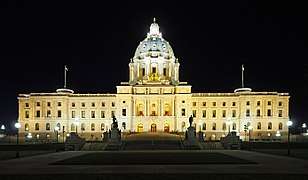 The Capitol at night
The Capitol at night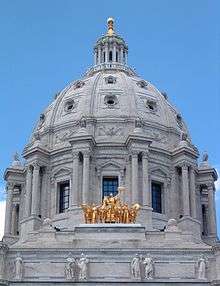 Marble dome
Marble dome- Golden quadriga above the south entrance
 Close up of the quadriga
Close up of the quadriga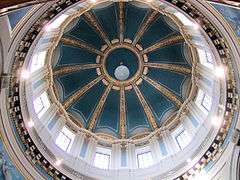 Inside the dome
Inside the dome Rotunda
Rotunda Mural depicting the North Star. Below the Star are the French words "L'Étoile du nord", which translates as "The Star of the North", which is also the state's motto.
Mural depicting the North Star. Below the Star are the French words "L'Étoile du nord", which translates as "The Star of the North", which is also the state's motto.- House of Representatives chamber
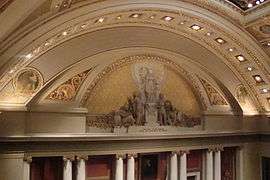 Above the House of Representatives chamber is Lady Minnesota with two pioneers to her left. To her right are a Native American chief and Sacagawea in honor of the people who lived in Minnesota before the pioneers. On the book that she holds in her left hand are both the dates of Minnesota's founding as a territory and state.
Above the House of Representatives chamber is Lady Minnesota with two pioneers to her left. To her right are a Native American chief and Sacagawea in honor of the people who lived in Minnesota before the pioneers. On the book that she holds in her left hand are both the dates of Minnesota's founding as a territory and state.
Memorials in the rotunda
- William J. Colvill Memorial
- James Shields Memorial
- John B. Sanborn Memorial
- Alexander Wilkin Memorial
Monuments on the grounds
 Knute Nelson Memorial
Knute Nelson Memorial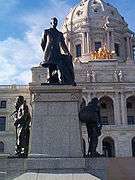 John Albert Johnson Memorial
John Albert Johnson Memorial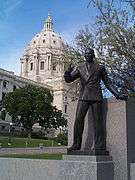 Floyd B. Olson Memorial
Floyd B. Olson Memorial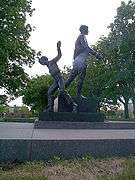 Charles Lindbergh Memorial
Charles Lindbergh Memorial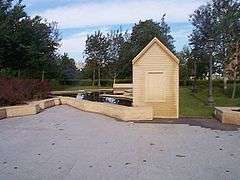 Minnesota Vietnam Veteran's Memorial
Minnesota Vietnam Veteran's Memorial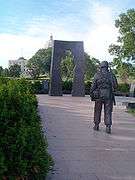 Minnesota Korean War Memorial
Minnesota Korean War Memorial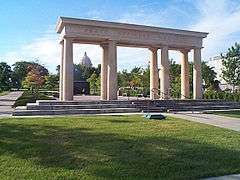 Peace Officers Memorial
Peace Officers Memorial Roy Wilkins Memorial
Roy Wilkins Memorial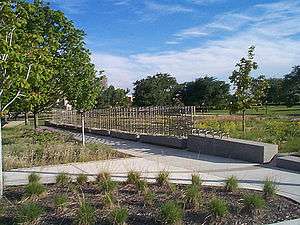 Women's Suffrage Memorial Garden
Women's Suffrage Memorial Garden Christopher Columbus Monument
Christopher Columbus Monument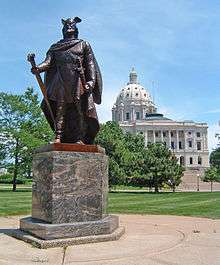 Leif Ericsson Monument
Leif Ericsson Monument Monument to the Living
Monument to the Living
See also
References
- ↑ National Park Service (2006-03-15). "National Register Information System". National Register of Historic Places. National Park Service.
- ↑ "Visit". Retrieved 4 April 2017.
- ↑ "The Minnesota State Capitol restoration project, explained". Retrieved 4 April 2017.
- ↑ "Minnesota Capitol: It's crumbling, but what a price tag". Retrieved 1 October 2017.
- ↑ "Minnesota State Capitol Restoration Project - Guiding Principles". Retrieved 1 October 2017.
- ↑ "Restoring the Glory: A balancing act for architects on Capitol restoration". Retrieved 1 October 2017.
- ↑ "Minnesota State Capitol Grand Opening Celebration - About the Restoration". Retrieved 1 October 2017.
- ↑ "Minnesota State Capitol Restoration Project - Art Subcommittee". Retrieved 1 October 2017.
- ↑ "Bitter fight over controversial Capitol art finally ends". Retrieved 1 October 2017.
- ↑ "After controversy, new Minnesota Senate Office Building finally opens – Twin Cities". Retrieved 4 April 2017.
- ↑ "Minnesota State Capitol Grand Opening Celebration - About the Restoration". Retrieved 1 October 2017.
- ↑ TEGNA. "First look: Minnesota's renovated capitol". Retrieved 4 April 2017.
- ↑ "Restored Minnesota State Capitol re-opens to the public". Retrieved 1 October 2017.
- ↑ Fitzgerald, Kilat (August 14, 2017). "Minnesota state capitol celebrates grand opening after restoration". La Crosse Tribune. Retrieved 2017-09-08.
- ↑ West, Tom (August 19, 2017). "Notes from a visit to our restored State Capitol". dairylandpeach.com. Retrieved 2017-09-08.
- ↑ "Minnesota State Capitol Grand Opening Celebration - Events Schedule". Retrieved 1 October 2017.
- Elmer L. Andersen. Elmer's Tour: A Former Governor's Loving Look at the Minnesota State Capitol. Nodin Press, 2005. ISBN 1-932472-38-X
External links
| Wikimedia Commons has media related to Minnesota State Capitol. |
- Minnesota State Capitol - Minnesota Department of Administration
- State Capitol Restoration Project - Minnesota Department of Administration
- Minnesota State Capitol Preservation Commission
- Minnesota Historical Society State Capitol webpage
- Gilbert sketch for the project

